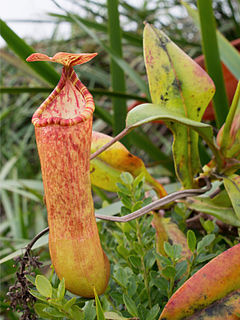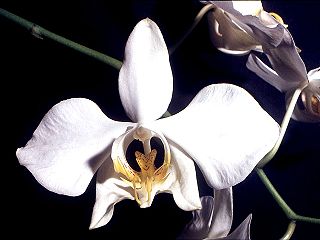
Pseudolarix amabilis, commonly called golden larch, is a species of coniferous trees in the pine family Pinaceae. The species are commonly known as golden larch, but being more closely related to Keteleeria, Abies and Cedrus, are not true larches (Larix). P. amabilis is native to eastern China, occurring in small areas in the mountains of southern Anhui, Zhejiang, Fujian, Jiangxi, Hunan, Hubei and eastern Sichuan, at altitudes of 100–1,500 m (328–4,921 ft). The earliest known occurrences are of compression fossils found in the Ypresian Allenby Formation and mummified fossils found in the Late Eocene Buchanan Lake Formation on Axel Heiberg Island.

Abies amabilis, commonly known as the Pacific silver fir, is a fir native to the Pacific Northwest of North America, occurring in the Pacific Coast Ranges and the Cascade Range from the extreme southeast of Alaska, through western British Columbia, Washington and Oregon, to the extreme northwest of California. It is also commonly referred to as the white fir, red fir, lovely fir, Amabilis fir, Cascades fir, or silver fir. It grows from sea level to 1,500 metres (4,900 ft) in the north of the range, and 1,000–2,300 m (3,300–7,500 ft) in the south of the range, always in temperate rain forest with relatively high precipitation and cool, humid summers. Common associate trees are western hemlock in northern ranges, Douglas fir in central areas, and in the extreme southern area of its range, California buckeye.

Artlish Caves Provincial Park is a provincial park on Vancouver Island in British Columbia, Canada.

The red-throated lorikeet is a critically endangered lorikeet endemic to Fiji. It is 18 cm long and is bright green overall, with red cheeks, throat and thighs.
The Anajapygidae are a small family of diplurans. They can be distinguished by their relatively short, stout cerci, which discharge abdominal secretions. Unlike most diplurans, which are largely predatory, these are scavengers.

Huari is one of the 16 districts that integrates the Peruvian province of Huari in the Ancash region. The district consists of the city of Huari, 15 small villages and 22 annexes.

Linnaea is a plant genus in the family Caprifoliaceae. Until 2013, the genus included a single species, Linnaea borealis. In 2013, on the basis of molecular phylogenetic evidence, the genus was expanded to include species formerly placed in Abelia, Diabelia, Dipelta, Kolkwitzia and Vesalea. However, this is rejected by the majority of subsequent scientific literature and flora.

The blue-chested hummingbird is a species of hummingbird in the family Trochilidae. It is found in Colombia, Costa Rica, Ecuador, Nicaragua, and Panama. Its natural habitats are subtropical or tropical moist lowland forest and heavily degraded former forest.

Erythroseris amabilis is a species of flowering plant in the family Asteraceae. It is found only in the Socotra Islands, part of the Republic of Yemen. Its natural habitats are subtropical or tropical dry forests and rocky areas. It is listed as an endangered species by the IUCN under the basionym Prenanthes amabilis.
Rhinella amabilis is a species of toads in the family Bufonidae that is endemic to Ecuador, only occurring in a severely fragmented area less than 100 square kilometres (39 sq mi).
Rhyacophila amabilis is an extinct species of insect in the caddisfly family Rhyacophilidae. It was endemic to the United States. It was first reported as extinct in 1986.

Nepenthes sumagaya is a tropical pitcher plant native to the Philippines. It is known only from Mount Sumagaya in north-central Mindanao, where it grows in open areas at elevations from 1600 m above sea level to the summit at 2247 m. It is sympatric with N. pantaronensis and possible hybrids between these species have been recorded. Owing to its unusual combination of morphological characters, N. sumagaya has no obvious close relatives in the genus.

Phalaenopsis amabilis, commonly known as the moon orchid or moth orchid in India and as anggrek bulan in Indonesia, is a species of flowering plant in the orchid family Orchidaceae, native to the East Indies and Australia, and widely cultivated as a decorative houseplant. It is an epiphytic or lithophytic herb with long, thick roots, between two and eight thick, fleshy leaves with their bases hiding the stem and nearly flat, white, long-lasting flowers on a branching flowering stem with up to ten flowers on each branch.

Linnaea amabilis, also known under the synonym Kolkwitzia amabilis and the English name beauty bush, is a species of flowering plant in the family Caprifoliaceae. It is a deciduous shrub grown as an ornamental plant. In China, where it originated, the plant is called wèi shí (蝟实).

Saint Amabilis of Riom was a French saint. Sidonius Apollinaris brought Amabilis to serve at Clermont.
Euseius amabilis is a species of mite in the family Phytoseiidae.

Marco Amabili is a Professor who holds the Canada Research Chair in Vibrations and Fluid-Structure Interaction, Department of Mechanical Engineering at McGill University, Montreal, Québec, Canada.

Crameria is a monotypic moth genus in the family Noctuidae erected by Jacob Hübner in 1819. Its only species, Crameria amabilis, was first described by Dru Drury in 1773.
Anajapyx menkei is a species of two-pronged bristletail in the family Anajapygidae. It is found in Central America.
Anajapyx vesiculosus is a species of two-pronged bristletail in the family Anajapygidae.













